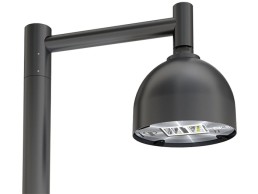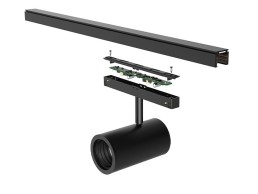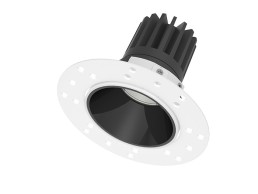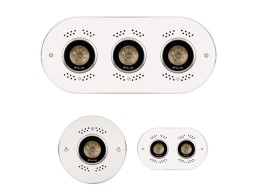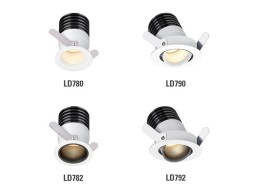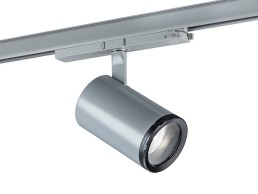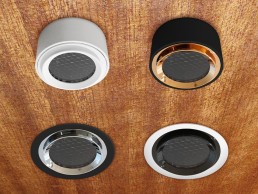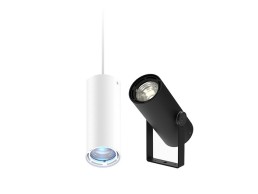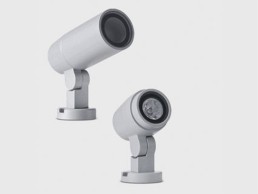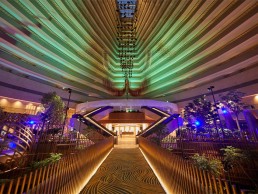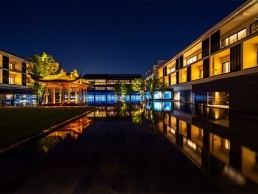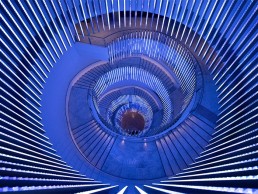Kingfisher Artelys
Combining elegant Italian design with powerful reflector technology, the Artelys series is the perfect solution for street, architectural and public realm lighting. Available in two body sizes as well as in a decorative lantern, and with an array of options such as optics and output, low colour temperatures, mounting styles and control compatibility throughout; this truly is a versatile luminaire.
eldoLED 48V DC 32W
eldoLED’s 48V DC 32W LED Track Driver maximises quality of light amidst track lighting miniaturisation and form factor constraints. It’s the only programmable track driver on the market that meets flicker performance industry requirements while achieving high-quality deep-dimming (0.1%) and tunable white applications. Make any hospitality lighting dreams a reality with DALI-2 DT8(Tc) lighting controls and eldoLED’s intuitive LightShape colour temperature and intensity control technology.
IBL Darklight
The new architectural Darklight downlights from IBL are available in sizes ranging from 60mm-100mm in diameter and a power consumption from 4.5W to 20W. The low glare specular reflectors come in polished chrome, polished black, matte black and polished gold (on request). Offering precise optics using the IBL Light Gathering Lens (LGL) technology, they can be dimmed using any dimming protocol. Two trimless options, with standard or plaster-in trimless kits are also available, as is a large selection of CTT, including dim-to-warm.
Filix Arpool
The Arpool Iris family of IP68 underwater adjustable luminaries brings a revolution in pool and water feature lighting design. With a 360° rotation and 20° tilt, the penetration of light through water goes beyond the optical capabilities. Multi-zoning, covering dark sports and creating depth illusions are easily achieved with vertical and horizontal installation. With a single IP68 connection feed, easy maintenance and replacement of engines is possible without removal from water.
LightGraphix Compact Downlights
LightGraphix has launched four new downlights - LD780, LD782, LD790, and LD792 - with single colour, 2-tone, fixed and adjustable options, rated IP65 for interior, exterior and marine applications. Bezel diameters start at 46mm, achieving an excellent size to output ratio delivering over 400lm. Colour temperatures range between 2200K-5000K and beam angles include several medium and a super tight 10° narrow. A single deep recessed optic ensures ultra-low glare, superior beam shape and no multiple shadows.
Hacel Aart
The new Aart Power Spot range by Hacel combines a contemporary style and minimalistic design with powerful performance and functionality. Featuring an adjustable beam in midi and micro sizes, the Aart is ideally suited to retail and spotlighting applications.
Available in a choice of lumen outputs, delivering up to 3845lms, it features adjustable beam widths (10° 20° 35° 50° 60°) and tilt adjustment 0° to 90°.
ELR Coin 24CV Recessed/Surface
Coin 24CV Recessed and Coin 24CV Surface puck lights are LED module hybrid luminaires derived from ELR’s Coin-24CV low height LED module, operating on 24V DC constant voltage that allows multiple luminaires to be driven by a single non-dim or phase/0-10V/DALI/DMX dimmable driver. These puck lights are equipped with built-in ATePSTM technology that protects LED lifetime against abnormally high temperature conditions and comes in ProART CRI~95, are especially suitable for applications within display shelves, kitchen cabinets, countertops, etc.
CLS Ruby Series
With the introduction of the new Ruby Compact series and many new variants of the larger Ruby, CLS offers an incredibly wide and deep portfolio of surface mounted and suspended fixtures. No less than 40 different lighting sources are available including RGBW, RGBA, Tunable White and Dim To Warm versions. Control options are DALI, DMX 512, Wireless DMX and Casambi Bluetooth. The Ruby series are furthermore available in four different power and four different mounting versions.
Unilamp Micro Alpha/Kubik
The Micro Alpha and Micro Kubik are compact in size and provide an unobtrusive lighting solution that will enhance any exterior setting’s beauty.
Colour temperature choices include 2700K, 3000K and 4000K with narrow beam, medium beam, wide beam and elliptical beam distributions.
An earth spike and tree strap are available as standard accessories. With public safety always in mind, the Micro series operates with low voltage.
Parkroyal Collection, Marina Bay, Singapore
At Singapore’s Parkroyal Collection Marina Bay, Light Collab has used light to breathe new life into the vast atrium space, creating an energising space both for guests, and for the abundant plant life.
The recently-renovated Parkroyal Collection, Marina Bay (formerly known as Marina Mandarin) in Singapore has seen the remaking of neo-futurist architect John Portman’s spectacular hotel. Originally built in 1987, the existing hotel has been transformed, with its vast atrium now filled with plant life and vibrant light, thanks to a new lighting scheme designed by Light Collab.
On entering the hotel, guests are greeted by an abundance of lush greenery, most notably a 13-metre green wall, and cascading planters that create a scenic, 180º view of a forest. The journey into the hotel also includes entering a glass lift and, on reaching the fourth storey, crossing a gently lit bridge, flanked by more greenery, to the reception desk.
Light Collab became involved in this re-lighting project after the client recognised the need for a lighting designer, due to the complexity of lighting up the newly introduced greenery in a space with little natural light, along with the new interior design scheme.
The challenge for Yah Li Toh, Principal of Light Collab, was to introduce layers of light into the impressive atrium space, working with limited existing lighting points, integrating the new and old elements, as well as effectively illuminating the trees and planting scheme with healthy, biophilic light.
While grow lights are definitely needed to support the growth of the garden, achieving certain technical requirements of photosynthetic active radiation levels, the general concern was how the exposed grow lights would co-exist with the general lighting and impact on the desired ambience for the hotel.
Toh explained further: “The architect had a vision of bringing the garden indoors, so we did a site study and measured the amount of daylight and PPFD (Photosynthetic Photon Flux Density) available at different times of the day, and unfortunately we realised that there was little PPFD that would be able to sustain the life of the plants and trees – the PPFD measured as little as 2-6 µmols/sqm on average in the proposed plant positions, while the botanist recommended levels of a minimum of 150-200 µmols/sqm, after conditioning the plants to require less daylight, in comparison to outdoor conditions of more than 1,000 µmols/sqm. There was also a limited time of exposure to daylight too.
“Although in Singapore, there are examples of green walls with plants and ferns being lit by grow lights, this is the first time that trees were planted in an atrium with very little daylight - as little as 2 µmols/sqm - and where the plants would be very visible to hotel guests from all angles at all times. The higher the output of PPDF, the higher the light intensity naturally. This meant that we needed a strong concept to work with the grow lights – they needed to have very controlled optics, with optimum PPFD output so as not to ruin the ambience of the hotel, focused enough to optimise growth on the trees and shrubs, and also co-exist well, look good, natural, and not give out the purple hue commonly seen in grow lights. We also studied and tested many brands of grow lights available, and the cost and performance differs greatly.”
The overall lighting concept was to enhance and complement the built form with the soft forms of nature. To do this, Light Collab therefore sought to use very controlled optics, the highest PPDF per watt, high R9, colour rendering and tunable white solution of the grow lights; by keeping the colour temperature at 3800K during the day, it creates the feeling of being in a forest in daytime, while in the evening, the temperature reduces down to 3100K, transforming the space into an atmospheric gardenscape. Lighting levels change throughout the day, responding to the natural lighting environment and the needs of the greenery. The grow lights also double up to form part of the overall scenes and ambience of the atrium, which was originally too dark before the renovation, while also supporting plant growth.
Complementing the grow lighting for the plant life, Light Collab also developed the interior architectural lighting for the common spaces of the hotel. This has been designed to enhance and highlight the ambience of the space, as well as elements of the interior architectural features, to create more focus and emphasis on the gardenscape. Light Collab’s lighting design incorporated the overall lighting in the reception, atrium space, as well as the landscape lighting. Lighting in the dining areas was also designed at ambient levels, allowing the greenery to take centre stage.
The key architectural considerations for the new lighting, Toh explained, were to “respect John Portman’s original architecture, and the new interior elements, features by FDAT Architects and the landscape content by Ramboll Studio Dreiseitl”.
Respecting the original architecture meant, for Toh, working around the huge, curving atrium space. Illuminating this vast space proved to be a challenge, but it was one that she relished. “In addition to the complexity of the 360-degree view, the growlights and plants, the upper guestroom corridors still had the original lighting strategy, which was implemented in 1987,” she said. “Some of the features were retained, such as the corridor lighting, which was kept darker so as to not gain too much attention. But the form of the atrium also posed challenges for light mounting options. It was interesting to try and work with the new elements, while respecting and balancing the existing elements.
“For the rest of the hotel, we also tried to balance the focus and bring attention to the atrium and the gardenscape,” she continued. “For example, in the all-day-dining restaurant, there were also special interior design features, but it was also about the view and the connection into the atrium. The interior design heavily used mirrors, reflective materials and curves, which all required careful integration.”
Throughout the project, Light Collab worked closely with the interior designers, along with the rest of the design team, to ensure that the lighting became synonymous with the wider design scheme. “For certain features, the other design consultants had an idea of how it should be lit, but it mostly required a vision to tie the concept together. There was a constant communication back and forth, and we hoped to be able to bring new perspectives to the space that the interior designers may not have thought about.”
Hanging in the centre of the atrium, suspended high above the plentiful plant life, is Orchidea, a sculpture created by American artist Richard Lippold. This sculpture was not previously lit with much consideration, instead just illuminated with some floodlights that had been in place since the 80s. Toh sought to use light as a means to breathe new life into the sculpture and make it the key focal point of the space. “We tried to bring new perspectives on how light can interact and bring life to the sculpture,” she explained. “Being metallic, it presented opportunities to create a shimmering effect.
“We used four narrow beam spotlights to highlight the sculpture, so that when the metallic parts move, they also create an interesting shimmer. We were limited though by the available positions to place fittings in the atrium without being too obtrusive and glaring to the hotel guests from various viewing points.”
In bringing new light to the Orchidea, Toh was presented with the opportunity to transform the sculpture into an integral feature of a light art show, interacting with its metallic forms and bringing extra life to the atrium each evening. The show, which runs hourly from 7-9pm, sees the atrium shift from a gardenscape into a futuristic space of light and sound, bringing out the artistic playfulness of the architectural elements within the atrium space.
The two-and-a-half-minute show has been designed to engage onsite volumes and planes with the Orchidea, enhancing the interaction of light and space with the suspended wires and geometric forms soaring through the atrium and engaging the space as a whole, further bringing out the mood of euphoric futurism and spiritual aspiration.
The combination of the artistic lighting for the Orchidea and the grow lighting for the plant life meant that this was a unique project for Light Collab, with a wide variety of challenges and hurdles that needed to be overcome. However, Toh explained that, with the support of an understanding client, they were able to comfortably overcome these challenges.
“It is the first project that we have completed where grow lights are used on trees in an interior space where there is not much daylight. The challenges are different, as we had to use artificial light to try and ensure the survival of the plants and trees, so my team and I felt a huge responsibility for this,” Toh explained.
“When we first conceived the idea of the various scenes in the atrium changing throughout the day, transforming from a “forest” to a “garden”, we also went further and looked at how we can possibly bring together all the elements in the atrium, together with the setting, the greenery, and the Orchidea sculpture, how we can transform the atrium with special scenes so that in this interior space, there is opportunity for variety, and things to happen. This is even more important, since there is no view out from the enclosed atrium, except for the skylight. Thus we felt it was important to create changes in scenes, to break the monotony at intervals. The client was very supportive with all of our ideas, allowing them to become reality.”
Since the project was completed last year, Toh has seen a swell of positive reaction to the new lighting within the hotel and how it serves to complement the overall space. She said: “We were excited and curious to see how people would react. Overall, we were delighted to see people taking photos and posting on social media, saying that it looks great at every angle, without having to add filters.
“We also noticed that people would come out of their guestrooms, and restaurant-goers would come in to see the Orchidea light show. Guests in the atrium would start becoming curious about the transformation happening.
“Lighting has brought life to the atrium for the people, while also doubling up as survival for the greenery – it is the perfect bridge for both people and plant life.”
Naera Hotel, Spa & Art Gallery, China
Merging art and light to create a beautiful feeling of escapism, Klaasen Lighting Design has helped to turn the Naera Hotel, Spa & Art Gallery in Xitang, China into a picturesque, relaxing retreat.
Born out of a passion for art, organic farming and international luxury travel, the newly-opened Naera Hotel, Spa and Art Gallery in Xitang, China, has been designed with rest and relaxation in mind. The resort, situated just over an hour’s drive from Shanghai, is the realisation of the childhood dream of owner and developer, Zhu Shu Lei of Xitang Zhidi Cultural Development, who, after failing to find an international operator brand that shared the same views and vision for his hotel concept, decided to create his own brand.
The resulting Naera Hotel is part of a wider redevelopment of East Xitang, and has been created to reflect his desire to provide a retreat based on top quality service, spa and wellness treatments, mixed with the beauty of art and the nourishment of organic farm food; around 2,000 different teas have been selected to be made available to guests, providing a different selection of teas in rooms each day.
A destination for escapism, from the moment guests arrive, they are transported into a different world. The drop off point is screened off from the busy main road by a dramatically illuminated wall, and guests enter through a “landscape portal”. From here, they travel through a meandering, uplit screen maze that leads to the reception. The deliberate maze walk is intended to wind people down on the way, centring their minds and spirit in calmness. Art works are also located along this walkway, and throughout the hotel, giving each journey a sense of exploration and discovery.
The Naera Hotel, Spa and Art Gallery has been designed by Shanghai architects Leeko Studio to reflect a typical Chinese garden, with all public spaces located around a central courtyard. Lighting for the resort was designed by Martin Klaasen and Grace Eng of Klaasen Lighting Design, with the intention of being the “glue” that reinforces and brings out the uniqueness of both the architectural design, and the interior design of Horizonal Space Design’s Ju Bin, while also adding to the sense of exploration, showcasing the artwork and creating a peaceful feeling of calmness in the Chinese garden. Throughout the resort, Klaasen and Eng utilised warm colour tones, concealed lighting and controlled light levels, with accent lighting to highlight artworks, in a scheme that adds to the experience for visitors.
“We didn’t have a specific lighting brief, but our approach was implicitly based on my prior collaboration with the interior designer, who loves our approach of concealed lighting, focused accents and controlled lighting levels, bringing into value the key features of the overall architectural and interior design,” explained Klaasen. “Our design style and understanding of the lead consultant’s design philosophy was key.”
The prior relationship that Klaasen shared with both the architect and interior designer Ju Bin is something that he feels helped throughout the process, as there was an immediate, implicit understanding between their goals and ambitions for the project. “When Ju Bin was approached for this project, he insisted to the client that he wanted us to be appointed as part of the team as well,” Klaasen continued.
“The close collaboration that we had was key to the success of this project, but more than that, it was the mutual trust and respect, and the ensuing friendship between the owner and his consultants that created the base for the success. When each expertise is valued, respect and understanding is shown for each other, the results generally surpass expectations, as was the case in this project. It also makes the collaboration a joy and motivates each member of the team to put in the extra mile.”
The harmonious relationship that Klaasen has with Ju Bin helped to create a space in which the lighting is seamlessly integrated within the wider architectural and interior design. Light serves as a tool to enhance the interiors and bring extra focus on the smaller details within each area, whether this is one of the art exhibits on display, or the materials used by the interior design team.
“Lighting is often called the glue that gels everything together, so the identity is created by the architect and interior designer, mostly. The lighting designer’s role is to create the appropriate lighting effects, moods, accentuation and dynamics that reinforce this,” Klaasen continued.
This is particularly evident in the entrance walkway, where the lighting is kept very minimal – there is no signage or downlighting, light is only used to illuminate the panelling that lines the corridor, with additional spots on the pieces of artwork on display. This minimalistic approach is something that was key to Klaasen’s lighting design, adding to the sense of intrigue and discovery for guests. “It was a deliberate choice, and one that came after close consultation with the design team and the owners to make sure that we were all on the same page,” he said. “As a general rule, lighting should have a supporting role, not a dominant or overpowering role. It’s about the space, and the experience of the space, not about the lighting itself.
“The intrigue and exploration of what the hotel has to offer is brought to life by the lighting, and by carefully choosing the lighting effect, the angles of impact and the moment of visibility as you move around. As the guest journeys around the hotel, the task of the lighting designer is to reveal the spaces, their architectural features, and art as a visual experience. It is planned, and it is timed.”
On practically every corner of every area throughout the resort, there are pieces of artwork – from guest rooms to the corridors, restaurants and even the washrooms. Klaasen Lighting Design therefore added focused spots of light to showcase each individual piece. However, this was not without its challenges, as Klaasen explained that going into the project, they didn’t realise quite how much artwork there would be. “We always knew that there would be art and artworks, but we never knew to what extent, how big, what shape, what size,” he said. “It was only in the last few months before the opening that we started to get a feel for what this fantastic art was going to be.
“We had to challenge ourselves to find solutions, because we had provisional lighting put in place, but it was without really knowing what was going to be put where, and I think even the artist only decided on some of the artworks once he was here. That meant that the infrastructure for lighting was there, but it was not perfect. We had to improvise along the way to bring in some additional lighting, move some lighting, maybe add in some conversion lenses or spread lenses – find ways to adapt to the situation that we had with the lighting that was already in place.”
The willingness and ability to adapt is something that proved beneficial for the entire design team throughout the project, as Klaasen explained that there were some instances where the interior designers would have suggestions for the lighting, while conversely, on other occasions, Klaasen posed alternatives for the interior design that would allow lighting to be better integrated.
Such examples can be found in the cove lighting, which required several adjustments to get just right, and in the recessed step lighting as well. However, despite these various challenges, Klaasen believes the strong sense of communication helped them through: “Like in all projects, your design is as good as the end result, so communication, supervision and site assistance to the contractors implementing your design are crucial to its success. Explaining and educating all parties involved in the realisation of your lighting design of the installation requirements and the intended lighting effects to be achieved is crucial.
“The challenges become even bigger if there are language barriers, but luckily our team was able to communicate our design intents in detail, and supervised to see the intended effects achieved.”
The desire to create a sense of wonder and discovery through lighting extended to the outside areas of the resort as well. The hotel is built around a central courtyard; inspired by typical Chinese gardens, this courtyard consists of a large body of water, punctuated with islands of trees and a central pavilion. The lighting here sought to utilise the reflections of the water to create a magical feeling of peace and calm.
This feeling was enhanced by the deliberate decision by Klaasen to avoid using any façade lighting on the hotel’s exterior. Instead, light emanates from within the building, where people are seen as silhouettes moving through the connecting corridors and walkways – it was a design decision that transforms the courtyard completely after dark. “During the day, the natural light lights up the building, you can see the architecture, you wonder what’s inside. After dark, it’s exactly the opposite,” he explained. “At night, the effects are practically reversed, with light radiating out from the interiors.”
This design decision meant that the lighting designers had to work hard to ensure that all outward facing areas had balanced lighting, with brightness kept at a level so that overall, it looked consistent and uniform – a difficult task when these areas, including the restaurant, bar, tea house, lobby and library, all had different lighting requirements. This was achieved though, through clever positioning of the lights and carefully managed dimming levels.
Because of the enclosed nature of the central courtyard, Klaasen had the opportunity to use the outward facing areas as elements in a special, colourful light show that can be viewed from all around the hotel. Playing at the top of each hour, sometimes with increased frequency, the show consists of carefully selected colours that slowly move or change. The play of colours has been designed to be non-intrusive, so that it does not interfere with the normal operations or public activities of the hotel, but instead creates a relaxing experience for guests to enjoy.
Since the hotel was completed, it has received a great deal of praise, from the staff at the resort who claim that the lighting design is some of the best that they have seen, to the interior designers who feel that Klaasen has truly captured the “Oriental” style of lighting. The client has also said that the lighting adds the “finishing touch to the hotel”, and Klaasen believes that the approach of the client was integral to the success of the project. “An understanding and respectful client that validates and trusts your expertise, mixed with a great vision and understanding of design and the design process, made a great difference,” he said.
“As a designer, a happy client is all you can wish for. It means you have more than satisfied their expectation, you validated their trust in you. If, as part of that, you also feel \you have fulfilled all your own design visions and expectations, you have realised a project close to perfection, something that does not happen often.”
He concluded: “The great collaboration, respect and understanding between the client and the design team has created a result beyond everyone’s expectation, myself included. It seamlessly integrates lighting, architecture, interiors and landscape as one overall experience.”
Crown Sydney, Australia
The newly opened Crown Sydney is the latest landmark on the Australian city’s iconic harbour. Lighting design from both FPOV and NDYLIGHT help bring this landmark to life.
Opened at the end of 2020, the towering Crown Sydney resort is a marvel of modern design that brings bespoke luxury to the heart of the city’s harbour.
Located in Barangaroo, Crown Sydney brings together a luxury hotel, apartments, restaurants, spa, retail and gaming under one roof in a new, world-class venue.
Designed by Wilkinson Eyre architects, Crown Sydney has been constructed not just to frame the views of Sydney Harbour’s icons, but to stand alongside them as a defining landmark of the city. The concept takes its inspiration from nature; composed of an elegant, curved geometry, the tower’s form is reminiscent of three petals that intertwine together towards the sky, and its sculptural shape maximises the opportunity for accommodation to make the most of the views of Sydney’s famous bridge and harbour.
Standing at 271.3-metres tall and spanning 72 storeys, it is the city’s tallest inhabited building, with only Sydney Tower, an observation tower, reaching higher at 305-metres. The curving geometry of the tower was derived using parametric 3D modelling and accommodates a 60º twist in the outer skin, with helical columns on the perimeter while maintaining a vertical core structure.
The curving façade is accentuated further by a series of tall, slender, curved elements pinned as an overlay to the glass and solid structure behind, known as ‘The Veil’. The original architectural concept for the resort included a lighting concept study, prepared by Speirs Major, that addressed intentions for the Veil façade at the lower levels of the development.
Having previously worked successfully with Speirs Major, lighting design studio NDYLIGHT was appointed by Crown Sydney to execute the design in 2015, a commission that not only included the Veil, but also guiding the whole authority lighting approvals process for the exterior lighting, which included aviation obstacle lighting and bringing together input from other consultants on external deck and signage elements to present authorities with consolidated approvals documents.
Steve Brown, Director of NDYLIGHT, explained further: “Not only did the Veil have to look great, but the lighting of it had to comply with AS4282 in terms of spill light, which was especially critical to both the residential developments across the road to the east, and to the nearby Sydney Observatory, with which significant discussions were held.”
With its slender, curving features, the Veil is almost whalebone-like in its colouration and structure, and its curvature made the modelling of the design, and the eventual illumination, an interesting challenge. Brown continued: “The conceptual design included a bit of a journey looking at whether we could affix luminaires to the Veil itself – which was quickly discounted – and studies whether some form of linear lighting solution at the base of the Veil would work; this was also discounted.
“After a serious amount of modelling, we decided that close offset individual luminaires with a significant amount of cross-lighting was the answer. As much as anything, this was driven by the available mounting locations: narrow canopies on the eastern and northern sides, and the glazed roof of the outdoor dining terrace on the harbour side.”
As the Veil is gently overhanging, it was possible for the lighting designers to employ uplighting from the canopies below, yet still terminate the beams of light in the structure by narrow lensing and tight focus, eliminating unwanted light spill.
Brown explained that it was never the intention that the Veil be evenly lit “as if it were a billboard”. But rather, it was felt that the lighting should support the organic semblance of its structure. “From concept through to execution, the goal was always to modulate the light to bring out the three-dimensional curvature of the Veil elements, and try to get some shadow play here and there,” he said. “In essence, the same as a lighting designer would try to do with a three-dimensional object on a theatre set.”
During the process of illuminating the Veil, NDYLIGHT worked with Illumination Physics, who approached the project at the time of tender with an alternative luminaire option that, Brown explained, “seemed to meet all the technical requirements needed for the successful execution”.
The luminaire option was its Circular Wash Series, fitted with asymmetric, Quattro lenses and glare shield accessories. However, as the designers sought to control unwanted light, Illumination Physics needed to design an elaborate anti-glare device. The design of the glare shield was complicated by the optics used, which produce a 60º beam in the long axis of the symmetric lens – honeycomb louvres cannot be used with wide-angle optics, and a standard snoot was also unsuitable as it too would interfere with the lighting effect.
Illumination Physics therefore designed a custom solution based on a full snoot with cut-outs to allow the 60º axis to function. Longitudinal louvres were also added in the same orientation, further reducing any view of the light source.
Brown continued: “The biggest issue was how to mount the luminaires above the canopies with a system that allowed the luminaires to achieve the requisite pan and tilt to ensure effective cross-lighting. A site mock-up was held, which confirmed both that the mounting would work, and the effect was ‘as expected’ – always an important milestone!”
The final installation of the Veil lighting was commissioned in December 2020, with the outcome looking “remarkably like the modelled version”. All the Veil lighting is dimmed, and runs at pre-curfew levels before 11pm, with a lower curfew level after 11pm to comply with light spill requirements.
Stepping inside the vast, curving tower, lighting designers at FPOV were tasked with designing the interior illumination. The studio has a long-standing relationship with Crown Resorts, dating back to its work on the City of Dreams project in Macau in 2005, and it has since worked on projects in Crown Melbourne, City of Dreams in Manila, and provided advice on projects in the UK and Sri Lanka.
In this instance, FPOV was asked to work with a team of various designers from around the world to make this flagship location “a benchmark project for the region”.
Mark Elliott, Global Creative Director at FPOV explained the interior lighting concept further: “Key to the client’s expectation was a feeling of drama, light and shade, all those tag words that we use in the description of what we deliver, but with a well-educated client, they really meant it and expected it to be delivered, and understood what was needed to deliver that.
“With a client like Crown Resorts, they are so knowledgeable about what the best in the hospitality industry are offering globally, why venues are successful and why some are not, that there is no hiding behind jargon or baffling with technology; you are pushed to deliver the best, anything less is unacceptable.”
Given that the project spanned five years from concept to completion, Elliott added that FPOV had to be careful in the initial design stage that what they were proposing would still be forward thinking when the project was complete and that “any of the innovations of iconic selections that were made would still be individual and not mainstream in the future”. As such, customised solutions for decorative equipment were fundamental, with a background of architectural lighting to support. Architectural lighting in this instance predominately came from IBL’s Lightkit, with additional fixtures from unonovesette and Intra Lighting complementing the statement decorative pieces throughout.
With the resort including a hotel, apartments and a spa, as well as a number of bars and restaurants, FPOV had the mammoth task of providing the lighting design for all client-facing spaces. However, while for some, such scope could be quite daunting, the FPOV team instead relished the additional challenges that a project of this size brings. “It was great because it meant that we were in control of the whole client journey from one space to the next, so we could create both harmony and contrast between spaces where appropriate,” Elliott said.
“The key challenge on a project of this scale is not necessarily the design, but the project management and the other 50% of what being a lighting consultant is about, a part of our job that is not only equally, but sometimes more important than the design: the consulting.
“The client takes many aspects of what we offer when selecting the right consultant, and sometimes the experience of ease of collaboration and coordination with a consultant can carry a heavy influence.”
The need for collaboration and coordination was intensified by the multiple design teams involved across the many aspects of the project. Elliott continued: “As with any large project, it’s a collection of smaller projects held together by the interconnecting transition areas, and there’s where the consistency comes in. The majority of our coordination was between Meyer Davis out of New York, which did the hotel and apartments, together with the MICE and some F&B spaces. Bates Smart worked through the gaming spaces and associated F&B venues, and then beyond that a series of specialist F&B design teams did the various venues across the tower.
“We were very lucky that we had worked with Bates Smart consistently on previous projects, and so there was a level of confidence in us that enabled us to make the suggestions we felt appropriate. They had specific ideas around what they wanted to achieve, especially in the decorative lighting arena, but we worked with them during mock-ups and samples.
“Meyer Davis were also a great team to work with, very calm and accepting of suggestions and input from other consultants. Their design is very personalised and far from a corporate approach to hospitality: layers of details, purposeful selection of materials for all applications, creating an accessible, luxury design aesthetic.
“They were both very collaborative and we all had to be that way on a project like this to ensure that we provided a fully integrated solution.”
Working with such a wide range of designers on the project could have created a series of headaches for FPOV as they sought to create a harmonious lighting scheme throughout the resort. But for the lighting designers, the challenge was working out when to create harmony, and when to do something different. Elliott continued: “With the plethora of interior designers on the project, and the variations in their styles, we needed to ensure that the lighting enhanced their aesthetic, while creating harmony throughout the project.
“We had to take prompts from the usage of the various spaces, together with the overall design aesthetic. An example of this would be in the Italian restaurant and the Nobu restaurant – the lighting techniques are generally the same, but there was a heavier focus on decorative lighting in the Italian restaurant to create a soft, warm ambiance, whereas in the Nobu restaurant, there was a much higher contrast, and it was more architectural.”
Integral to the building’s design is its twisting, curved form; while this is architecturally incredibly impressive from the outside, such a shape caused further complications for the interior design.
Elliott explained: “The building is effectively a twisting, irregular-shaped cone, so all the external walls tapered either in or out. Each of the hundreds of guest rooms were therefore not only a different size, but also a different shape, which meant that every room needed individual consideration. This is an epic task, given that in a typical hotel you would have a handful of room types, but here we had many.”
Alongside the many contrasting guest rooms, an integral architectural feature within the hotel is the vast, swirling podium spiral staircase, which forms a key focal point for the main entry. Although the staircase doesn’t extend into the lobby, visitors have a clear view through the void from the lobby space. Accentuating this iconic statement, FPOV used light to enhance both the form and volume of the staircase, while providing an additional layer of luxury that “only a hotel resort provides”.
“I’m particularly proud of the solutions we used for the focal staircase,” Elliott said. “Wilkinson Eyre created the space, form, volume and flow of the staircase through the 3-4 floors it transitioned as an architectural statement at the heart of the building, but a hotel resort demands some sparkle and luxury extravagance; so we designed what I would term as an “architectural chandelier”, fused into the structure of the balustrade so that the form wasn’t impacted, but the visual impact was definitely there when you needed it through the opportunity to create dynamic and colour changing solutions for special occasions.”
Following the hotel’s opening in December 2020, Elliott reflected on how this project, and in particular its sheer scale, compared to others that he has worked on in the past. “Years ago, during my time at Isometrix, I worked on the Hotel Puerta America in Madrid, which had a multi-faceted team of interior designers on a single project, but it didn’t quite have the scale of areas this project had.
“Subsequently, I have worked on a number of large hospitality projects, but this would be the first that brought the two challenges together on this scale.
“One thing that held this project apart from others, for me, was the quantity of custom-designed feature elements, driven by the need for individuality, that were always designed via a collaborative process between my team and the interior designers and clients – sometimes led by the interior design team, sometimes by our team, and sometimes by the client.”
The strong collaborative nature of the project is something that has stuck with Elliott since its completion and is one of the defining aspects of large-scale projects such as the Crown Sydney, maybe even more so than the design itself. “On a project of this scale, one that challenges you over a number of years, you can expect to form relationships with other consultants that will endure. And hopefully the design we delivered, and the process of our consultation and collaboration has formed these relationships to take forward to other challenges,” Elliott reflected.
“It’s an exercise in design, but also a journey to improve on your weaknesses and expand and take advantage of your strengths. At the end of a project like this, there is a feeling of relief, but also pride and gratitude that you have learnt something new in the process.”
While the strong sense of collaboration is one of the crowning achievements for Elliott, he and his team at FPOV have created a lighting design that beautifully complements the wider design of the Crown Sydney and its myriad areas.
Looking back at the overall lighting design, Elliott concluded: “As with any project that is appropriately illuminated, lighting brings the project to life, enhances materiality and form, encourages clients to move through the spaces, to enjoy the venues in an environment conducive to a luxury experience and provides a multi-dimensioned, day-to-night, tailored and bespoke destination.
“You can tell very early on when a project is going to be one to remember, I have a few key projects that I think define my career, and this is now certainly in the fold.”


